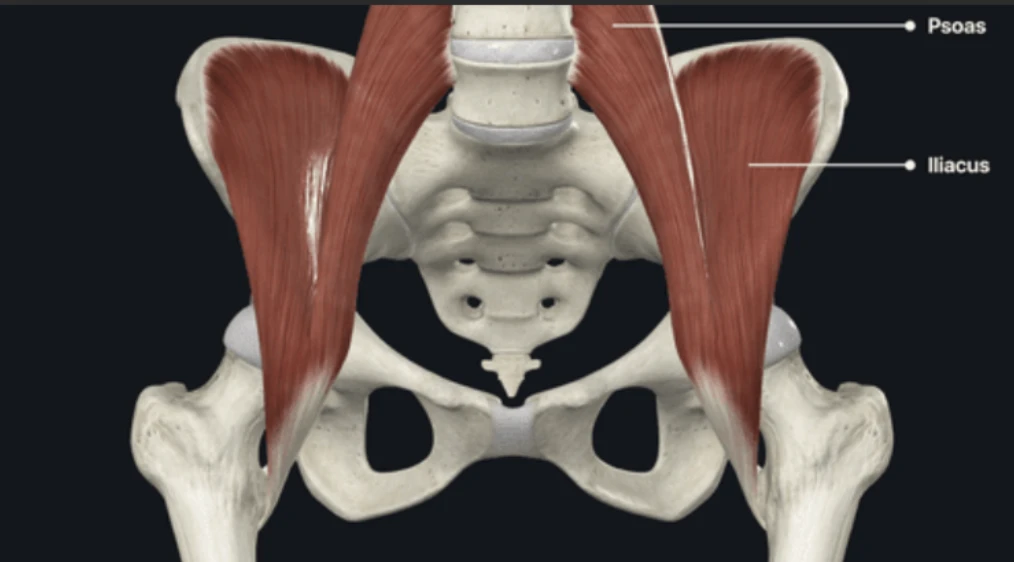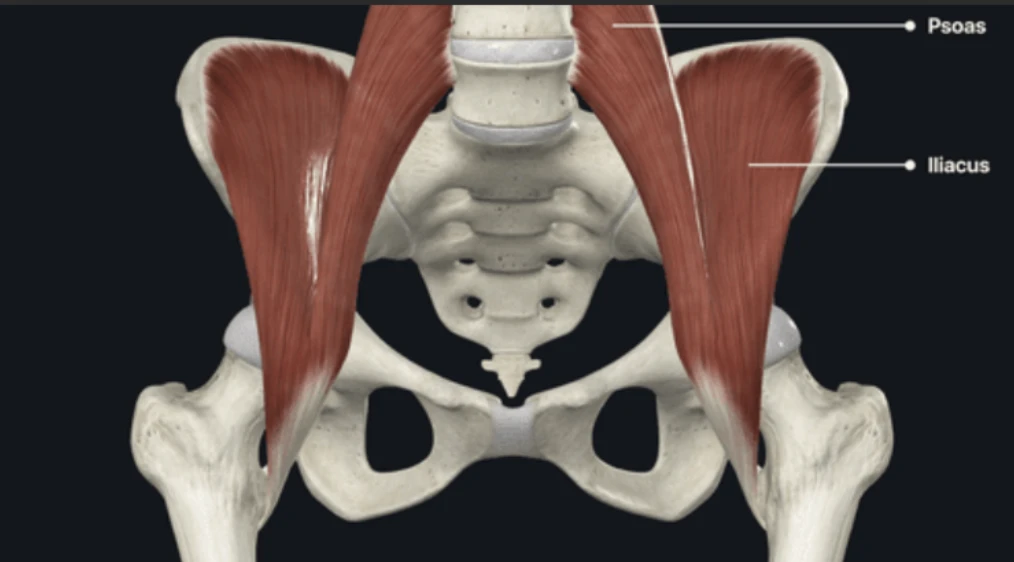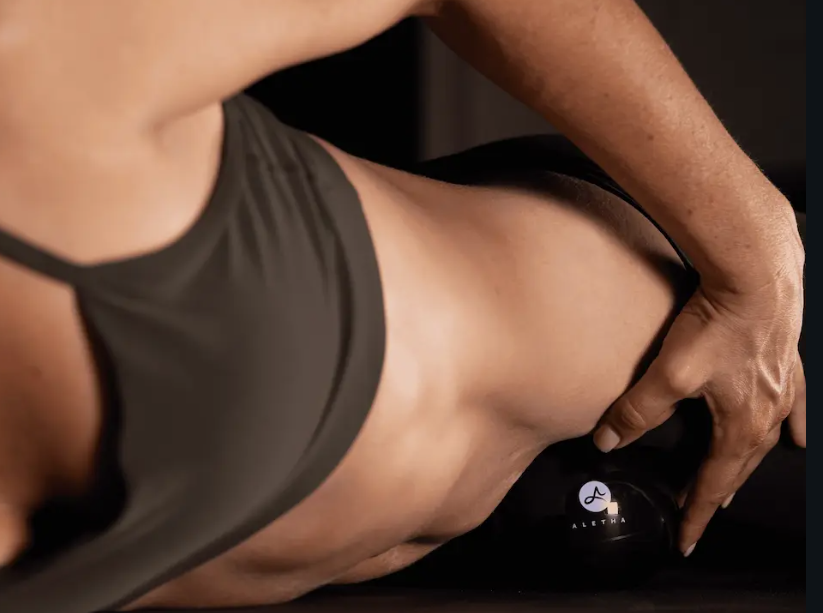Your cart is currently empty!
Understanding and Managing Hip Flexor Pain

Unlock relief from hip flexor pain! Learn about causes, symptoms, and effective strategies, including targeted tools and exercises, to keep your hips healthy and pain-free.
Hip flexor pain can sideline even the most dedicated recreational athlete. These muscles, crucial for activities from running to yoga, are often tight and prone to injury. Let’s explore what you need to know to keep your hip flexors healthy and pain-free.

Where is your hip flexor? – Anatomical illustration of the hip flexor muscles
What are the Hip Flexors?
Your hip flexors are a group of muscles that allow you to flex your hip, i.e., lift your knee to your chest and bend at the waist. Key players include:
- Understanding Your Hip Flexors: The Iliacus
When you think about lifting your knee or bending at your waist, a group of muscles called your hip flexors are hard at work. One of the key contributors to this movement is the iliacus. This powerful muscle is located in your iliac fossa, which is the inner surface of your hip bone (ilium). From there, it travels downwards and joins with the psoas major muscle (which we’ll discuss next) before attaching to your femur, the large bone in your thigh. Essentially, the iliacus plays a crucial role in directly pulling your thigh upwards, enabling that essential hip flexion movement.
- Understanding Your Hip Flexors: The Psoas Major
Another vital muscle in the hip flexor group is the psoas major. This deep-seated muscle originates from the vertebrae in your lower spine (specifically the lumbar region). It then travels downwards through your core and pelvis, eventually merging with the iliacus muscle to form the iliopsoas tendon, which attaches to your femur. Because of its connection to the spine, the psoas major is not only important for flexing your hip but also plays a role in stabilizing your lower back and influencing your posture. It’s a powerful muscle that bridges your upper and lower body.
- Other Hip Flexor Helpers
While the iliacus and psoas major are the primary powerhouses for hip flexion, it’s worth noting that other muscles also contribute to this movement. These include the rectus femoris, which is part of your quadriceps muscle group and also helps to straighten your knee, and the sartorius, the longest muscle in your body, which assists with both hip and knee flexion, as well as hip abduction and external rotation.
Where is Hip Flexor Pain Felt?
Pain typically presents in the front of your hip, groin, or even lower back.You can also feel pain in knee, ankle, and foot if these muscles are tight. You might notice it when:
- Walking or running
- Lifting your leg
- Stretching
- After exercise
Common Causes of Hip Flexor Pain
- Muscle Imbalances and Weakness: Often, hip flexor pain isn’t solely due to tightness in the hip flexors themselves but rather an imbalance with weaker opposing muscles, particularly the glutes and core. When the gluteal muscles are weak, the hip flexors may compensate during movements like walking, running, or lifting, leading to overuse and strain. Research has highlighted the importance of gluteal strength in maintaining proper hip mechanics and preventing injuries. For instance, a study published in the Journal of Orthopaedic & Sports Physical Therapy emphasized that “gluteal muscle activation deficits are common in individuals with various lower extremity musculoskeletal disorders, including hip pain” (Powers, 2010). Similarly, a weak core can compromise pelvic stability, forcing the hip flexors to work harder to stabilize the trunk and pelvis during movement, contributing to their overload.
- Prolonged Sitting and Sedentary Lifestyles: In today’s increasingly sedentary world, prolonged sitting is a major culprit in hip flexor issues. When you sit for extended periods, your hip flexors are held in a shortened position. Over time, this can lead to adaptive shortening and stiffness of these muscles. This shortened state reduces their ability to lengthen properly during activities, making them more susceptible to strain and injury when suddenly stretched or engaged. A review in Sports Health: A Multidisciplinary Approach noted that “prolonged static postures, particularly sitting, can contribute to muscle length adaptations and potentially lead to musculoskeletal pain syndromes” (Lynch et al., 2010). This shortening can also tilt the pelvis anteriorly, further exacerbating tension in the hip flexors and potentially contributing to lower back pain.
- Repetitive Hip Flexion Activities (Overuse): Athletes and individuals engaging in activities that involve repetitive hip flexion are particularly vulnerable to hip flexor pain due to overuse. Sports like running, cycling, dancing, soccer, and martial arts constantly engage the hip flexors to bring the leg forward. This continuous contraction and eccentric loading can lead to micro-traumas in the muscle fibers, resulting in inflammation, pain, and reduced flexibility. The cumulative effect of these repetitive movements can overwhelm the muscles’ capacity for recovery.
- Acute Injuries and Trauma: While less common as a chronic cause, acute injuries can directly lead to hip flexor pain. These often occur from sudden, forceful movements, such as sprinting, kicking, or rapid changes in direction, which can cause tears or strains within the muscle fibers. Direct impact to the hip area can also result in contusions or muscle damage. The severity of the pain and the recovery time depend on the grade of the muscle strain, ranging from mild discomfort in a Grade 1 strain to significant pain and loss of function in a Grade 3 tear. If you’ve sustained an acute injury to the hip flexor area, see your healthcare provider for assistance.
- Poor Biomechanics and Movement Patterns: Inefficient or improper movement patterns can place undue stress on the hip flexors. For example, in runners, overstriding or a lack of hip extension can force the hip flexors to work harder to pull the leg through, leading to strain. Similarly, in weightlifting, improper form during exercises like squats or deadlifts can shift the load onto the flexors rather than the intended larger muscle groups. These suboptimal biomechanics create chronic overload on the hip flexors, increasing their susceptibility to pain and injury.
Tools for Deeper Hip Flexor Relief
Beyond traditional stretching, tools like the Aletha Health The Mark and Aletha Health The Orbit can help you achieve deeper relief by targeting specific areas of tension.
- Aletha The Orbit: Use The Orbit first as a warm up to help improve overall blood flow and reduce generalized muscle stiffness. Gently roll the Orbit along the length of your hip flexor muscles and surrounding areas like your quadriceps and glutes. This can aid in recovery and prepare your muscles for movement.

- Aletha The Mark (formerly Hip Hook): This tool is designed to reach the deep-seated iliacus and psoas muscles that make up a significant part of your hip flexor group. This is the first tool that can use the iliacus on its own. You can use the Mark by lying on your stomach and positioning the tool directly over the tender spot in your hip flexor. Slowly lower your body onto the tool, allowing its unique design to apply pressure and help release deep-seated tension. Hold for at least 90 seconds, focusing on relaxing into the pressure.
[ Include video on how The Mark works on the hip flexor: https://youtu.be/WhZiloNGYlQ ]
- Finish up with The Orbit on the piriformis: After using the Mark on your hip flexors, return to The Orbit to further address the piriformis. This can help release any residual tension in the surrounding hip musculature and promote overall hip mobility. To target the piriformis muscle, which is located deep in your buttock and can contribute to hip discomfort, lie on your back with your knees bent and feet flat on the floor. Place The Orbit under your glutes on the side you want to target. Gently roll and find tender spots in the piriformis area, holding pressure as needed.
Leverage Exercises and Stretches for further Hip Flexor Relief
These exercises and stretches can help alleviate pain and improve flexibility in addition to using the tools:
- Hip Flexor Stretch: Kneel on one knee, with the other foot forward. Gently push your hips forward until you feel a stretch in the front of your hip.
- Half-Kneeling Hip Flexor Stretch: Similar to the hip flexor stretch, but focuses on a deeper stretch.
- Lunge Stretch: Step forward into a lunge, keeping your back straight and gently pushing your hips forward.
- Pigeon Pose: A yoga pose that stretches the hip flexors and rotators (If you have a knee injury, you may want to avoid this exercise).
Actionable Advice for Using Your Aletha Tools for Managing Hip Flexor Pain
To get the most out of your Aletha tools, try incorporating these practices into your regular routine:
- Targeted Muscle Release: Utilize The Mark to address deep hip flexor tension effectively, leading to quicker relief. Pay particular attention to areas where you notice tightness or experience tenderness.
- Gentle Stretching: Incorporate gentle stretches that target the hip flexor muscles. Following your stretches, you can further enhance relief by using The Mark on any lingering tight or tender spots.
- Strengthening Exercises: Building strength in your hip flexors and surrounding muscles can provide better support and stability. Consider incorporating these exercises:
- Marching in Place: Stand tall and lift one knee towards your chest, then slowly lower it and repeat with the other leg. Focus on controlled movement.
- Standing Hip Flexion: While standing, lift one leg straight forward, keeping a slight bend in your knee. Lower it slowly and repeat on the other side. You can add resistance with a light ankle weight as you progress.
- Seated Knee Raises: Sit upright in a chair with your feet flat on the floor. Lift one knee towards your chest, then slowly lower it. Repeat with the other leg.
- Leg Raises (Lying Down): Lie on your back with your legs straight. Keeping your core engaged, lift one leg a few inches off the ground and slowly lower it. Repeat with the other leg. For a more challenging variation, lift both legs simultaneously.
- Consistent Application: Regular and consistent use of your Aletha tools can be a valuable strategy for preventing discomfort, enhancing flexibility, and supporting your body’s recovery after physical activity. Remember to pay attention to your body’s signals, begin with light pressure, and gradually increase the intensity as you feel more comfortable.
Learn more about Aletha Health’s Story on our website and follow us on Instagram to see the tools in action, making an impact on thousands of people.
References:
- Lynch, T. L., Whiteside, D., & Kelly, M. (2010). Prolonged static postures and their effects on musculoskeletal health. Sports Health: A Multidisciplinary Approach, 2(4), 310–317.
- Powers, C. M. (2010). The influence of altered lower-extremity kinematics on the development of musculoskeletal pain and injury: a review of the literature. Journal of Orthopaedic & Sports Physical Therapy, 40(2), 42–56.
Leave a Reply